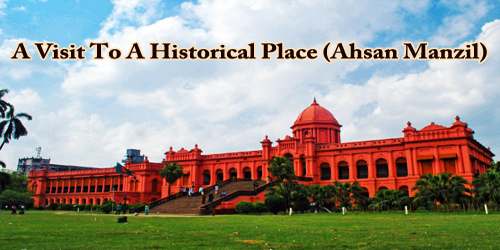Introduction: Man is not satisfied with what he has seen and known. He wants to see and know more. He wants to get the flavor of the historical places, So as a student I have a keen interest to know the historical places of my country. Whenever I get an opportunity, I visit a place of historical interest. During the last summer vacation, I got such an opportunity to visit Ahsan Manzil, a place of great historical importance.
Historical Places: In Bangladesh, there are some historical places. They are now regarded/declared as the World Heritage Sites. The Sundarbans, Mahastangarh, Kuakata, the Buddhist Vihara at Paharpur, Lalbagh Fort, Ahsan Manzil, Sonargoan, Bagerhat, etc. are the places of historical importance. Each place has its specialty and importance.
History of Ahsan Manzil: Ahsan Manzil (Bengali: আহসান মঞ্জিল, romanized: Ahsan Monzil) situated at Kumartoli of Dhaka on the bank of the Buriganga, was the residential palace and the kachari of the nawabs of Dhaka. It has been turned into a museum recently. It was said to be the Rang Mahal of Sheikh Enayetullah, a zamindar of Jamalpur pargana (Barisal) during the time of the Mughals. Having purchased it from his son Matiullah, the french made it their trading center. Khwaja alimullah bought it from the French in 1830 and converted it into his residence, effecting necessary reconstruction and renovations. Nawab Khwaja abdul ghani engaged Martin and Company, a European construction and engineering firm, to make a master plan for their residence.
The construction of the palace was begun in 1859 and completed in 1872. Abdul Ghani named it Ahsan Manzil after his son Khwaja ahsanullah. At that time the newly built palace was known as Rang Mahal and the earlier one was called Andar Mahal. Ahsan Manzil was pertly damaged by a terrible tornado On April 7, 1888, particularly the Andar Mahal of the palace. Nawab Ahsanullah rebuilt the Andar Mahal and repaired the Rang Mahal using good quality bricks that were brought from Raniganj. The exquisite dome of the present Rang Mahal was interposed. Ahsan Manzil was badly damaged again by the earthquake of 12 June 1897. However, Nawab Ahsanullah had it repaired again.
After the death of Khwaja Ahsanullah in 1901, the glory of Ahsan Manzil was ended. His successors could not continue the glory because of the internal family quarrel. They rented different parts of the palace to tenants, who actually made it a slum. In 1952, govt. acquired the property and left in supervision of the Dhaka Nawab court. In 1985, Dhaka National Museum acquired the property and made it a museum following a massive restoration program that utilized historic photographs of the property.
Description and Construction: Ahsan Manzil has now been converted into a museum and a popular tourist attraction of old Dhaka. It is one of the significant architectural monuments of the country. Established on a raised platform of 1 meter, the two-storied palace measures 125.4m by 28.75m. The height of the ground floor is 5 meters and that of the first floor 5.8 meters. There are porticos of the height of the ground floor, both on the northern and southern sides of the palace. An open spacious stairway has come down from the southern portico, extending upto the bank of the river through the front garden. There was once a fountain in the garden in front of the stairs, though it does not exist today. The spacious north and south verandas of both the floors rest on semicircular arches. The floor is covered with marble.
To construct the dome of Ahsan Manzil, the square room on the ground floor was given a round shape with brickwork in the corners. The room was then given an octagonal shape near the roof by squinches. This octagonal shape took the form of the drum of the dome. Finally, the kumud kali (buds of lotus) shaped dome was constructed by gradually slanting the eight corners to the peak. The dome is 27.13 m high from the ground.
The palace Ahsan Manzil is divided into two parts: the eastern side and the western side. The eastern building with the dome is called the Rangmahal and the western side with the living rooms is called Andarmahal. The high octagonal dome is placed on the central round room. There is a large drawing room, card room, library, stateroom, and two other guest rooms are located on the east side of the palace. The ballroom, the Hindustani room, and few residential rooms are situated on the western side. A beautiful vaulted artificial ceiling, made of wood, decorates the drawing-room and the Jalsaghar. A splendid dining hall and few smaller rooms are placed on the west part. The floors of the dining and Darbar Halls are decorated with white, green, and yellow-colored ceramic tiles. The famous storeroom, where the valuables of the Nawabs used to be stored, was in the middle of the five rooms located in the western half of the ground floor. Along with those rooms, a Darbar Hall or assembly hall and a chest room is also placed there.
There are attractive wooden stairs in the room that is attached to the north of the domed room. The balusters were ornamented with vine leaves made of iron along the railing of the stairs. The wooden ceiling of the room, decorated with geometric designs, is very elegant. The verandas and rooms are covered with marble. The doorways are placed within semicircular arches. The thickness of the walls of the palace is about 0.78 meters. The doorways are placed within semicircular arches. The inner doors had multi-colored glasses and the exterior ones were of wood with designs. Wooden beams supported the roof of these rooms. Iron beams have been used in constructing the roof. The architecture and the decoration is one of a kind in whole Bangladesh.
The construction of the famous dome of the Ahsan Mazil, which is at the center of the palace, took a lot tedious planning. The square room on the ground floor was built with a round shape and brickworks were done around the corners. To give the room an octagonal shape, squinches were given around the roof corners. The eight corners of the octagon was slanted gradually to make the dome look like the bud of a lotus ( kumud kali). The peak of this dome is 27.13 m above the ground. Ahsan Manzil was severely damaged during the tornado that occurred on 7th April 1888.the western block of Andermahal was completely demolished and later it was entirely rebuilt. The present-day dome, which is situated on the top, was built during the time of reconstruction. This place was also damaged during the earthquake of 1897 but Nawab Khwaja Ahsanullah repaired the whole place again.
Renovation: Recognizing the historical and architectural importance of the Ahsan Manzil, the government of Bangladesh took the initiative to renovate it. In 1985 Ahsan Manzil and its surroundings were acquired. After the completion of the renovation work in 1992 under the supervision of the Directorate of Public Works and Architecture, it was brought under the control of Bangladesh National Museum (20 September 1992). A museum has been established there. Considering the historical importance and architectural significance of Ahsan Manzil palace, the government was trying to conserve it since the later part of the Pakistani rule. The father of nation Bangabandhu Sheikh Mujibur Rahmancanceled its auction proposal option. On November 2, 1974, he ordered to establish a museum and tourist center after its proper conservation.
After the implementation of the work on the museum started, most of the nawabs house area, along with the half of the portion of the Andarmahal, remained beyond acquisition. The total area of the acquired land was 5.65 acres. Out of that, 0.68 acres from northern side was given to Dhaka City Corporation to establish a super market and 4.96 acres of land with the palace buildings remained for museum purpose. In 1986, the work began according to the above order keeping the original structure undisturbed and reconstructing the old environment as far as possible. After the completion of the renovation work in 1992, under the supervision of the Directorate of Public Works and Architecture, it was brought under the control of Bangladesh National Museum (20 September 1992). A museum has been established there.
Glory Days and Decline: In 1874, Lord northbrook, Governor General of India attended an evening function here in the palace when he came to lay the foundation of a water works installed by Nawab Abdul Ghani. In 1888, Lord dufferin also accepted the hospitality offered at Ahsan Manzil. In 1904 Lord curzon, on a visit to East Bengal, stayed in this palace on 18 and 19 February to win public support for the proposed Partition of Bengal.
Almost all political activities of Nawab Khwaja salimullah centred round this palace. Ahsan Manzil was the cradle of the All India Muslim League. With the decline of the nawabs of Dhaka, Ahsan Manzil also started to decline. When in 1952 the Dhaka Nawab State was acquired under the East Bengal Estate Acquisition Act, it became impossible for the successors of the nawabs to maintain the palace due to financial constraints. Nawab Khwaja habibullah shifted his residence to Paribag Green House soon after the acquisition of the zamindari. The palace was on the verge of collapse in no time as successors rented out rooms without considering its dignity. Over the years illegal occupants turned the place into a filthy slum.
Conclusion: Ahsan Manzil is really a place of historical interest. I spent 3 hours there with my family and saw many historical things and enjoyed them very much. I left Ahsan Manzil but the memory still haunts my mind.
















